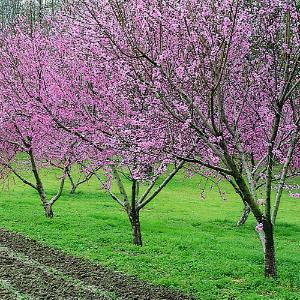Peach and nectarine trees Beautiful spring blossoms and sweet, juicy fruit make peaches and nectarines favorites for the home garden. The trees look alike and have the same cultural needs; the main difference is that the fruit of peaches is fuzzy skinned, while that of nectarines is smooth. The many peach and nectarine varieties tend to be adapted to specific regions; one kind or another can be grown in the Southeast, Mid-Atlantic, central and lower Midwest, Southwest, temperate Great Lakes regions, California, and dry-summer areas of the Pacific Northwest and intermountain West. There are extra-hardy selections suitable for parts of the Northeast. To decide on the best peach or nectarine for your area, consult a local nursery or your Cooperative Extension Office. Most peach and nectarine varieties need 600 to 900 hours of winter chill. In mild-winter areas, choose those with a low chill requirement. Most kinds are self-fertile. A standard peach or nectarine grows rapidly to 25 feet high and wide, but pruning can keep trees to 10 to 12 feet. A number of genetic dwarf selections are available, ranging in height from 4 to 10 feet. Training and pruning Peaches and nectarines are best trained to an open center. Mature trees need more pruning than other fruit trees do. They produce fruit on 1-year-old branches; severe annual pruning renews the fruiting wood. Each dormant season, remove a quantity of wood equivalent to about two-thirds of the previous year's growth. To do this, prune out any weak or crowding new growth; then head back the remaining branches to staggered lengths, so that fruit will form throughout the crown. Cut back some branches by one-third, others by two-thirds, and the remainder nearly all the way. Keep the center open by removing any vigorous shoots growing through the middle. Pests and diseases Peach tree borer is the most serious pest. It tends to attack stressed trees, so prevention through good growing conditions is the best control. Diseases are usually more of a problem in humid, mild-winter regions than in areas with dry, hot summers and chilly winters. Ailments you may encounter include peach leaf curl and brown rot of stone fruit. To control brown rot, prune trees to improve air circulation; also collect and dispose of diseased fruit. For chemical controls and timetables for treatment, contact your Cooperative Extension Office.


